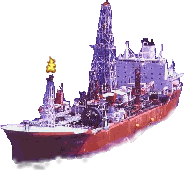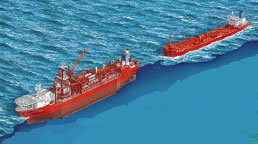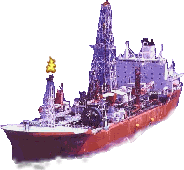

The 'Single Well Oil Production Ship' (SWOPS) was primarily intended for operations in the North Sea. In 1997-1998 the Seillean was upgraded to work in deepwater, which was off the coast of Brazil.
SWOPS is essentially a dynamically positioned (DP), segregated ballast oil tanker, which incorporates the following facilities:
· 26,500 barrel per day processing plant (gross throughput). Maximum oil production is 17,600 standard stock tank barrels per day (upgraded to 20,000) and maximum produced water handling capability is 15,000 barrels per day.
· Storage and transport facilities for 300,000 bbls (barrels) (approximately)
· A 65/8" Riser which can connect to a subsea wellhead. The wellhead was originally deployed and recovered via a moonpool on the ship.
When in production mode, maintaining station is consequent upon dynamic positioning, with the Ships stern directed into the waves and wind by azimuthing controllable pitch (CP) thrusters.
Shipboard power is provided by a hybrid system of gas turbine and diesel driven generators. These are operated such that when fuel gas is available, the gas turbine generators, supplemented where necessary by the diesel driven generators, generate electrical power. When fuel gas is unavailable, the diesel driven generators provide the power, supplemented by the gas turbine driven generators operating on diesel oil.
The Seillean is capable of discharging cargo in the conventional way which tankers do, but during the 1998 upgrade, an offtake reel system was installed which allows a pioneering DP ship to ship discharge of cargo to a DP shuttle tanker.
Extensive fire & gas detection, protection, and extinguishing systems are provided. Monitoring, status indication and control is affected from the bridge.

Seillean is a self contained, dynamically positioned, itinerant test and production Ship. Its principal functions are:
· To produce crude oil from exploration wells completed on the seabed
· To store the stabilised produced oil
· To discharge the stored oil to a shuttle tanker
Principal features
The Seillean is a mono-hull design, generally of tanker configuration with accommodation and main machinery aft.
A production riser is deployed from a Moonpool, via a derrick located amidships. The oil processing plant is located immediately forward of the production riser Moonpool and below the Main Deck.
A lattice tower is located forward, supporting flare tips for burning the off-gasses produced from the process plant.
A second Moonpool for the deployment of a small Remotely Operated Submersible Vehicle (ROV) is located forward of the oil process plant.
Dynamic Positioning
When the ship is in the production mode (as opposed to Transit/propulsion mode), the vessel is connected to the seabed by the production riser, which has no anchoring effect. Many rigs and FPSO (Floating Production Storage & Offtake) units are often anchored to the seabed. One of the main features of dynamic positioning (DP), is the ability to operate in any depth of water, whereas anchoring is subject to shallower water depths. Therefore the Seillean is almost constantly in propulsion opposed to some rigs and FPSO's which are fixed.
The Seillean is held on station with the stern to the wind and waves, by a DP computer system, which controls the operation of up to seven thrusters.
During propulsion mode only two thrusters are normally required, but can be backed up by a third if required. The thrusters are of equal power, but are not of equal thrust, this is dependant on the hull form, location etc. All units operate at a constant speed, with variable thrust achieved by a change in the pitch of the propeller blades. The output from the thrusters is controlled by a duplicated control system.
· One Transverse Tunnel Thruster in the Forepeak
· Two Steerable (azimuthing), Retractable Thruster Units in the Forward Thruster Room
· Two Steerable (azimuthing), Retractable Thruster Units in the Engine Room
· Two Steerable (azimuthing), Non-Retractable Thruster Units in the Aft Thruster Room
The Aft Steerable Thrusters are normally used for the Ship's propulsion, when in passage and may be supplemented by Thrusters 4 and/or five in the Engine Room.
When on station, the process plant stabilises the crude oil produced from the subsea wells. Most of the separated associated gas is used to fuel the gas turbine driven electrical generators, with the surplus burnt at the flare.
Any water produced with the crude oil is separated and treated, then can be either discharged, via an oil in water monitor, overboard or stored onboard in dedicated produced water and slops tanks.
The stabilised crude oil is pumped from the process plant to six Cargo Oil Tanks. The flow of crude oil into the cargo tanks is metered to fiscal standards.

There are three levels of riser disconnection:
· Normal
· Rapid
· Emergency
Normal disconnection
On completion of a production run, the process plant is shutdown and the riser disconnected from the wellhead. The wellhead valves will be closed at the end of the production run, which normally leaves a column of crude oil in the riser string (the pipeline from the wellhead to the ship). This is depressurised and the contents displaced into the production plant using the Riser Flushing Package. The Riser will then be released from the wellhead utilising the hydraulic de-latching controls. This disconnection can also be used when deteriorating weather conditions interrupts production.
Rapid & Emergency disconnection
Rapid or emergency disconnection of the Riser will be necessary under one, or a combination of the following factors:
· Failure of the DP system to maintain the Seillean's position within design limits, due to malfunction of the reference computer control or power generating systems
· Shipboard or wellhead emergency requiring immediate disconnection, e.g. major fire
· Sudden and unpredicted deterioration of weather beyond upper operating threshold.
In any event the wellhead and process plants are designed to failsafe and shutdown or disconnect as required.
A completely automatic system is provided for matching power supply to demand, and to reduce demand in the event of an overload.
The Main Power Generation System comprises of diesel generators (DGs) and gas turbine generators (GTs). The GTs are normally used to provide power for oil production and positioning equipment when the Seillean is on location, when fuel gas is available from the oil processing plant. In fact power is provided from a combination of both diesel and gas turbine driven generators, depending on the availability of fuel gas.
Gas Turbine Generators
Gas Turbine
Manufacturer: Ruston
Type: TB5000
Rating: 3.6MW
Speed: 1,800 rpm
Generator
Manufacturer: GEC
Rating: 6.6kV, 3-phase, 60Hz, 3.3MW
Speed: 1,800 rpm
Main Diesel Generators
Engine
Manufacturer: Harland & Wolff
Type: H&W/MAN - B&W 8L 40/45
Rating: 4.4MW
Speed: 600 rpm
Generator
Manufacturer: GEC
Rating: 6.6kV, 3-phase, 60Hz, 4.2MW
Speed: 600 rpm
Harbour/Standby Generator
Engine
Manufacturer: Harland and Wolff
Type: H&W/MAN - B&W 8L 28/32
Rating: 1.68MW
Speed: 720 rpm
Generator
Manufacturer: Harland and Wolff
Rating: 440V, 3-phase, 60Hz, 1.5MW
Emergency Generator
Engine
Manufacturer: Cummins
Type: VTA28G2
Rating: 662kW
Speed: 1,800 rpm
Generator
Manufacturer: Newage
Rating: 440V, 3-phase, 60Hz, 0.5MW
Website by www.jcwebdesigns.co.uk
© All images and information subject to copyright. All rights reserved 2005 - 2009